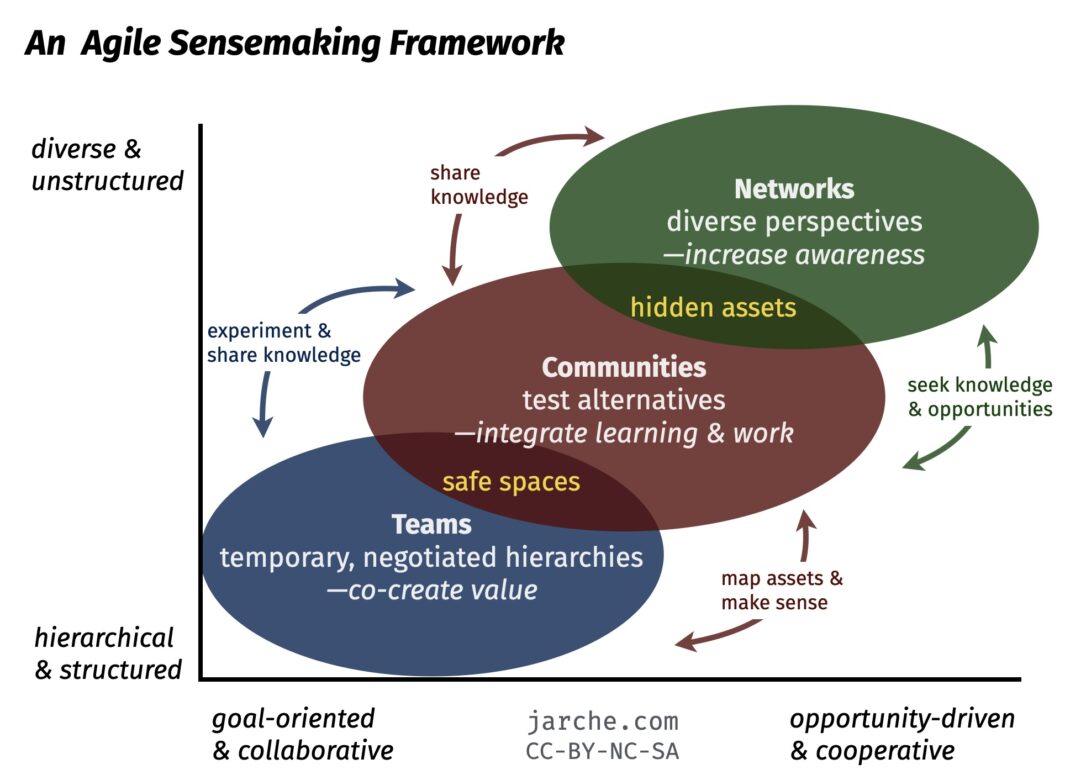Ed Morrison posted on LinkedIn an overview of his approach to innovation ecosystems and working with Wabash, a large transportation, logistics, and distribution company. As regular readers may know I am a huge proponent of Ed’s strategic doing framework and particularly how it applies to agile (with a small ‘a’) sensemaking.
Ed states that an innovation system consists of three types of “networks embedded in other networks”.
This framework directly aligns with the agile sensemaking framework consisting of — professional networks, communities of practice, and work teams, linking their work and learning. Ed concludes with the unique aspects of innovating networks.
In the short promotional video for Wabash’s Ignite conference, they state that the everyone in the company is part of a network, interconnected, and that partnerships are the key to the ecosystem’s health and success. They go on to say that, “Each one of us must participate. Each one of us must contribute. Each one of us has a place we can go to make our relationships stronger together.”
My experience with these frameworks is that it can be a challenge for people in hierarchical organizations to think in terms of networks. This is where the safe space of communities is critical, and why I have suggested that communities are the new conference. As more of our work is networked, trust and safe spaces will become critical. My suggestion for this Ignite conference would be to ensure it promotes the creation of communities that last longer than a few days in Kentucky. Our perpetual beta coffee club is five years old and we are still contributing and learning.

Ed states that an innovation system consists of three types of “networks embedded in other networks”.
> In affinity networks, participants promote their shared interests.
>> In learning networks, participants help each other learn and adapt.
>> In innovating networks, participants create shared value through collaboration and recombinant innovation.
This framework directly aligns with the agile sensemaking framework consisting of — professional networks, communities of practice, and work teams, linking their work and learning. Ed concludes with the unique aspects of innovating networks.
Innovating networks are different. Participants collaborate. They create new, shared value in response to a complex challenge. They create value through recombinant innovation—linking, leveraging, and aligning assets embedded in their networks.
Participants in innovating networks operate with high levels of trust. They will reveal their hidden assets because their partners have formed a reliable pattern of matching words with deeds. Because trust fuels these innovating networks, they take time to form.
In the short promotional video for Wabash’s Ignite conference, they state that the everyone in the company is part of a network, interconnected, and that partnerships are the key to the ecosystem’s health and success. They go on to say that, “Each one of us must participate. Each one of us must contribute. Each one of us has a place we can go to make our relationships stronger together.”
My experience with these frameworks is that it can be a challenge for people in hierarchical organizations to think in terms of networks. This is where the safe space of communities is critical, and why I have suggested that communities are the new conference. As more of our work is networked, trust and safe spaces will become critical. My suggestion for this Ignite conference would be to ensure it promotes the creation of communities that last longer than a few days in Kentucky. Our perpetual beta coffee club is five years old and we are still contributing and learning.

